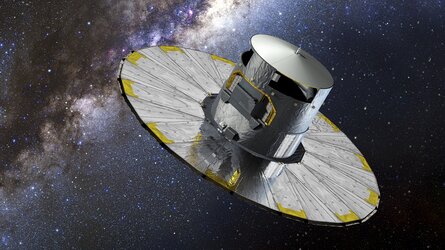
Gaia tracing starry strings in the Milky Way
This simulated video shows ESA’s Gaia spacecraft as it traces the structure and star formation activity of a large patch of space surrounding the Solar System. Gaia launched in 2013, and is on a mission to chart a three-dimensional map of our galaxy, pinpointing the locations, motions, and dynamics of roughly one percent of the stars within the Milky Way – along with additional information about many of these stars.
The video begins with a view of Gaia set against the bright plane of the Milky Way, which cuts horizontally across the frame. Different coloured patches – each representing a different stellar ‘family’ observed by Gaia – then come into view, with yellows, greens, blues, purples and reds gradually filling up the region and creating a rainbow patchwork effect. Each family is identified with a different colour and comprises a population of stars that formed at the same time.
Gaia then disappears from view, and the perspective zooms out to show the wider three-dimensional structure of the colourful star populations, along with their future paths through the galaxy based on Gaia’s measurements of proper motions (the motions have been speeded up for illustration purposes, with each second corresponding to 158730 years).
A recent study using data from Gaia’s second data release revealed that the most massive among these familial groups of stars may keep moving together through the galaxy in long, string-like configurations for billion of years after their birth, as shown in this video. Finally, the patch of space investigated in this study, covering a radius of around 3000 light-years around the Sun, is presented in the wider context of the Milky Way.
The new study uncovered nearly 2000 previously unidentified clusters and co-moving groups of stars in just over 3000 light-years from us (roughly 750 times the distance to Proxima Centauri, the nearest star to the Sun). The study also determined the ages for hundreds of thousands of stars, making it possible to track stellar families – as shown in this video – and to uncover their surprising arrangements and orientations.
Credit: ESA/Gaia/DPAC; Data: M. Kounkel & K. Covey (2019); Animation: S. Jordan / T. Sagristá / Gaia Sky (http://www.zah.uni-heidelberg.de/gaia/outreach/gaiasky) – CC BY-SA 3.0 IGO






